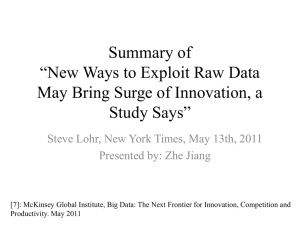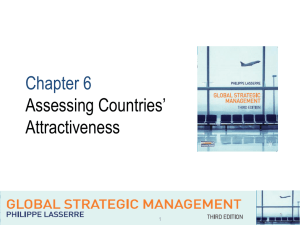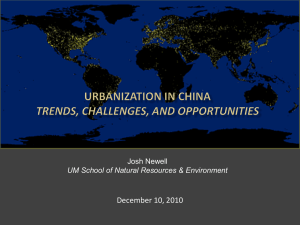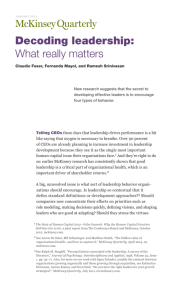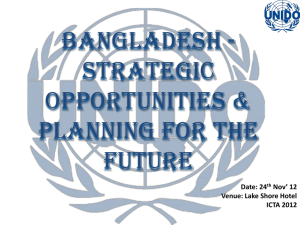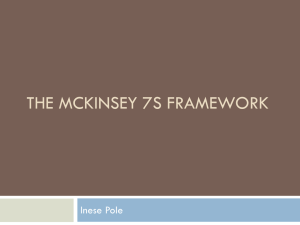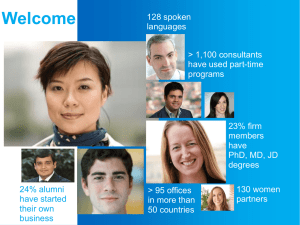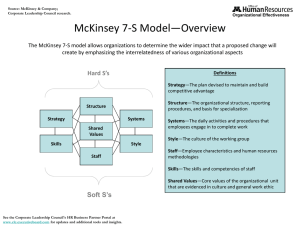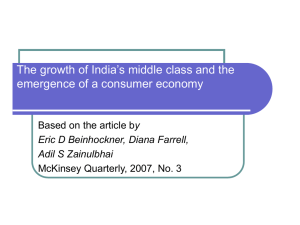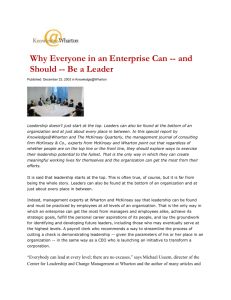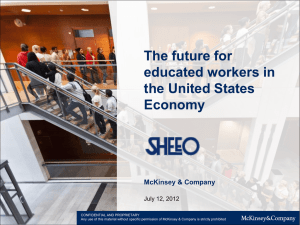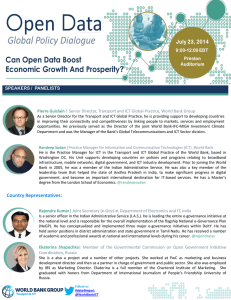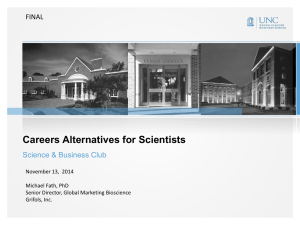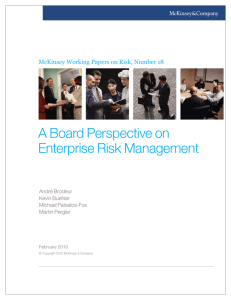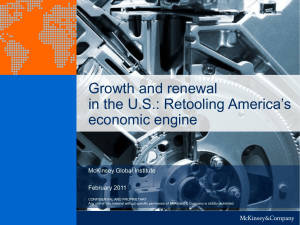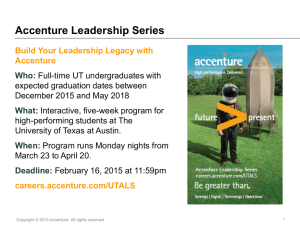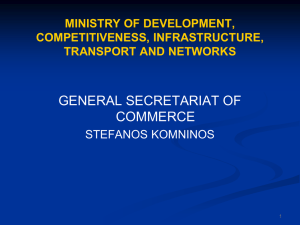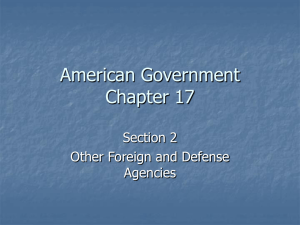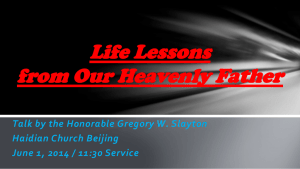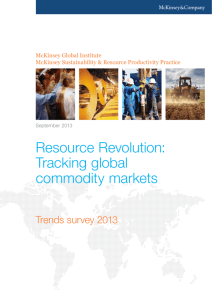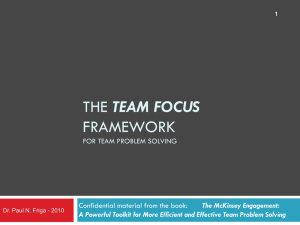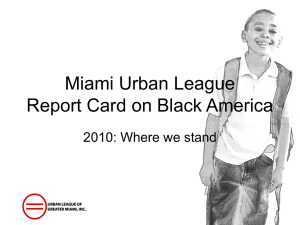Knowledge Strategy and McKinsey
advertisement
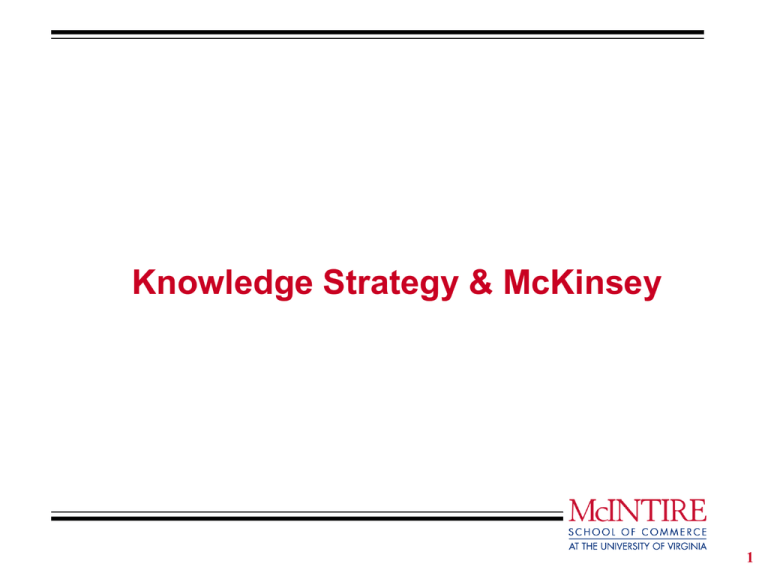
Knowledge Strategy & McKinsey 1 Value Propositions and Accenture Common KM Value Propositions • Effectiveness/Responsiveness. • Efficiency. • Innovation. Accenture • KXchange – representative approach and mindset of many! • Technology: D-Base, Discussion Forums, Collaborative Tools and Expertise Locators. • Massive investment in technology and organization infrastructure. • Works well with repeatable work (when you can drive re-use) and where information is really what needs to be transferred. 2 Information Versus Knowledge in Retail Banking 3 Types of Knowledge EXPLICIT Documents Databases Reports Manuals Engineering Methods TACIT Know What • Facts • Ideas • Theories • Intuition • Beliefs • Values Know How • Routines • Procedures • Instructions • Expertise • Instincts • Informal Practices Dialogue Conversation Mentoring Experience Apprenticeships Coaching 4 1. Knowledge & Strategy. 2. KM at McKinsey. 3. Remembering 9/11. 5 Cluster in groups of 2-3… My left side of the room focus on codification. Be prepared to discuss: • • • • Randall Love’s search The overall strategy and economics Primary investments in technology and infrastructure to support it. Incentive schemes (and focus) My right side of the room focus on personalization. Be prepared to discuss: • • • • Marcia Blenko’s search The overall strategy and economics Primary investments in technology and infrastructure to support it. Incentive schemes (and focus) Where Would You Characterize Accenture? McKinsey? 6 Choose between Two Strategies Codification • Link is person-to-document • Extract, store and share through computers • Reuse codified knowledge across similar tasks Personalization • Link is person-to-person • Share and apply through people networks • Channel expert advice to unique problems 7 Codification: Access Health Call-in medical center with 500 nurses Nurses assess and direct patients Use 500 pre-developed software algorithms “We’re not inventing new ways to cure decease. We’re taking available knowledge and inventing processes to put it to better use.” CEO Joe Tallman 8 AH relies on “Reuse Economics” 4500 Costs: 1 algorithm=$40,000 variable costs=$20. Avg. cost per diagnosis (dollar) 4000 3500 3000 2500 Usage: For first 300 algorithms; reused 8,000 times on average last year 2000 1500 1000 500 0 0 100 200 300 400 500 600 700 800 no. times reuse of software algorithm Reuse of knowledge assets drives profits, not economies of scale based on volume 9 Personalization: Memorial Sloan Kettering Cancer Center No. 1 rated cancer center in the U.S. Most innovative and customized cancer treatment in the country Heavily based on personal communication between doctors, scientists, etc. Co-located in 17 disease teams; meetings Investing heavily in re-use misses the point here 10 Different strategies, different drivers Codification Fast, efficient delivery of products “reuse economics” People: “implementers” Personalization unique solutions to unique problems “expert economics” People: “inventors” 11 Incentives and IT systems differ IT for Codified: heavy investments “library” + search engines IT for Personalized: minor investments “people-finders” + search for people Incentives for codified: - to write up documents, - to use documents Incentives for personalized: - to help others directly - to ask for help 12 1. Knowledge & Strategy. 2. KM at McKinsey. 3. Remembering 9/11. 13 McKINSEY 3 minutes to come up with THE answer • What strategically differentiates McKinsey? How does KM (repositories, collaborative technologies and employee development) play into this? • What were the key elements of the knowledge management project launched in 1987? • Be prepared to discuss the Jeff Peters vignette. Specifically, how did he solve his problem? • What challenges does McKinsey face as evidenced in the case and vignettes? 14 General Case Questions: McKINSEY • What strategically differentiates McKinsey? How does KM in terms of repositories, collaborative technologies and employee development play into this? • Solve tough, high-end and big-dollar problems that require a high degree of expertise and creativity. • People are inventors, not implementers. • Most problems are unique and solutions customized. • KM investments for them are heavily oriented to connecting people. • Technically (expertise locators and even repositories) • Organizationally (staffing and culture). 15 General Case Questions: McKINSEY • What were the key elements of the knowledge management project launched in 1987? • A common database of client work (e.g., sales presentations, deliverables, analytic techniques, etc.). • Client Sectors and Competence Centers hired a full time practice coordinator to monitor quality and direct consultants to content. • Established both I shaped and T shaped career paths. • Knowledge Resource Directory (paper-based) of firm experts and documents. How important was it that the 2,000 documents that Matasonni and Manville collected be high quality? 16 Jeff Peters in Sydney • Be prepared to discuss the Jeff Peters vignette. Specifically, how did he solve his problem? • Issue: Bid for growth strategy of respected financial services organization. But local industry expertise “conflicted out.” • Resolution: Immediately began using his personal network. Via this found Jeff Peters in Boston (though unavailable for 6 weeks). • His help: 1) John Peacocke (New Zealand – 2 years in McKinsey – mostly oil and gas); 2) Patty Akopiantz (1 Year Associate with prior I-Bank experience) and 3) Jonathon Liew (first McKinsey assignment). • Forged group of experts from all over the world. • Found 179 relevant PD documents and followed up with 60 more people. • Won the project and client bought in. • Jeff not happy though (no breakthrough too much reliance inside firm). 17 18 Video Points of Importance • For you aspiring consultants, note the opening comment about the pressure to come up with a unique solution (with little experience). • First stop is PD Net. They do re-use documents. But note that they also use these documents to determine who to turn to for help. • Key is finding the 3-4 teams somewhere around the globe that can coach you through the process. • Culture in McKinsey where you both add to the knowledge base and when you respond when asked. • In part a product of the “One Firm” culture and hiring. • Performance evals. from day one also emphasize both knowledge contribution (PD output) and help to others. • Personal development and feedback built in at all stages. • Learning during an engagement via feedback sessions. • Development key to assignments during engagement. 19 General Case Questions: McKINSEY • What challenges does McKinsey face as evidenced in the case and vignettes? • Managing growth: Difficult to scale the way Accenture does. • Leveraging external expertise: • Reaching outside the firm. • Integrating experienced hires. 20 A Web of “Effective” Information Flow… Hierarchy = Associate = Manager = Associate Principal = Principal & Director 21 A low proportion of people regularly reach outside McKinsey for knowledge 55 Under 1 year Over 1 year 55 Experienced hires are the main exception 32 27 8 McKinsey Boston McKinsey other Client 11 4 8 Other * Percentage of top 7 information contacts from each source type 22 We are three times less likely to go outside our pod for regular information Information 9 sharing* 8 7 6 vs. 5 4 3 2 1 0 Within same pod Neighboring 2 pods pod away More than 2 pods away (or different floor) Distance * Weekly information sharing out of a possible 100% of interactions 23 1. Knowledge & Strategy. 2. KM at McKinsey. 3. Remembering 9/11. 24 What does this have to do with knowledge management?? 25 Give Me Five Minutes of Thought How can KM be applied to national security? • Within Agencies? • Between Agencies? • Targeting Initiatives. • Educating. • Us • Them 26 KM and National Security Within Agencies Bureaucracy Can Stifle “Knowing What We Know.” • CIA developing an ability to surge. • NSA is creating new leadership networks and data mining algorithms. Turf Wars Between Agencies (CIA and FBI) Preclude Action. • Homeland Security Office (22 agencies, 200,000 employees and $37.5B) • Bio-Terrorism Response Capability. 27 9/11: A Data (Dis)Integration Case Study January 2000: Mohamed Atta obtains U.S. visa Who knew? State Department June 2000: Atta meets with Iraqi intelligence in Prague Who knew? Central Intelligence Agency June 2000: Atta enters the U.S. Who knew? Immigration and Naturalization Service 28 9/11: Case Study, Continued July 2000: $100K wired to Mawan al-Shehhi, pilot of one of two planes that struck WTC Who knew? Treasury Department December 2000: Atta and al-Shehhi leave stalled airplane on Miami runway Who knew? Federal Aviation Administration July 2001: Agent warns of potential terrorists in training at U.S. flight schools Who knew? Federal Bureau of Investigation 29 KM and National Security Within Agencies Bureaucracy Can Stifle “Knowing What We Know.” • CIA developing an ability to surge. • NSA is creating new leadership networks and data mining algorithms. Turf Wars Between Agencies (CIA and FBI) Preclude Action. • Homeland Security Office (22 agencies, 200,000 employees and $37.5B) • Bio-Terrorism Response Capability. Targeting Interventions. • Combat almost exclusively about information. • A key target is finding and disrupting networks. 30 Prior Contacts Small World Metrics • CC = 0.41 • CPL = 4.75 • Shortcuts = 0.19 31 http://www.orgnet.com/MappingTerroristNetworks.pdf KM and National Security Within Agencies Bureaucracy Can Stifle “Knowing What We Know.” • CIA developing an ability to surge. • NSA is creating new leadership networks and data mining algorithms. Turf Wars Between Agencies (CIA and FBI) Preclude Action. • Homeland Security Office (22 agencies, 200,000 employees and $37.5B) • Bio-Terrorism Response Capability. Targeting Interventions. • Combat almost exclusively about information. • A key target is finding and disrupting networks. Educating Different Parties. • How do you help create understanding amongst disparate groups? • Religious and socio-economic differences. 32 Discussion Questions For Class On Knowledge Generation Be prepared to tell me about the knowledge brokering steps (and provide examples at each point). 33
